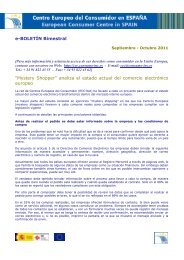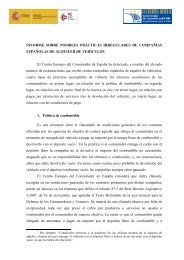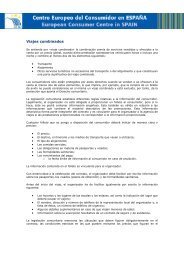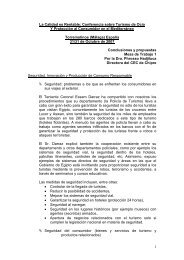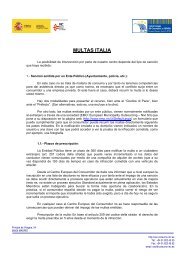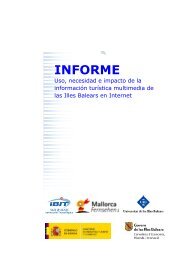The European Online Marketplace: Consumer Complaints
The European Online Marketplace: Consumer Complaints
The European Online Marketplace: Consumer Complaints
Create successful ePaper yourself
Turn your PDF publications into a flip-book with our unique Google optimized e-Paper software.
<strong>The</strong> <strong>European</strong> <strong>Online</strong> <strong>Marketplace</strong>:<br />
<strong>Consumer</strong> <strong>Complaints</strong><br />
Bilbao, 23 of September 2005<br />
Fredrik Nordquist ECC Stockholm
<strong>European</strong> <strong>Consumer</strong> Centre<br />
• Initiated and party funded by the<br />
<strong>European</strong> Commission<br />
• ECC offices in 23 countries.<br />
• <strong>The</strong> task of the ECC is to give advice and<br />
assistance if the consumers encounter<br />
problems when buying products and<br />
services from companies in other EU<br />
member states.<br />
• <strong>The</strong> aim is that the consumer should feel<br />
as confident when shopping in another<br />
country as he/she does at home.
Fredrik Nordquist<br />
• Senior Administrative Officer/Legal<br />
Adviser at the ECC in Sweden<br />
• Project leader and author of the ECC<br />
e-commerce reports<br />
• Guest lecturer in International b2c<br />
e-commerce law at the Gothenburg<br />
University and at the University of<br />
Strathclyde in Glasgow, Scotland<br />
• Academic background:<br />
LL.M. Master of Information Technology<br />
and Telecom Laws. University of<br />
Strathclyde, Glasgow, Scotland.
ECC e-commerce reports<br />
• 2003: <strong>The</strong> realities of the <strong>European</strong> online<br />
marketplace<br />
• 2004: <strong>The</strong> <strong>European</strong> <strong>Online</strong> <strong>Marketplace</strong>:<br />
<strong>Consumer</strong> <strong>Complaints</strong><br />
• 2005: <strong>The</strong> <strong>European</strong> <strong>Online</strong> <strong>Marketplace</strong>:<br />
<strong>Consumer</strong> <strong>Complaints</strong> 2004
“<strong>The</strong> realities of the <strong>European</strong><br />
<strong>Online</strong> <strong>Marketplace</strong>”<br />
Published in June 2003<br />
Shopping project: 114 cross-border<br />
purchases and 262 website checks.<br />
Main problems identified:<br />
• Non-delivery of ordered goods<br />
• No reimbursement if the product was<br />
returned within the cooling-off period<br />
• Many websites lacked necessary<br />
information
<strong>The</strong> <strong>European</strong> <strong>Online</strong><br />
<strong>Marketplace</strong>:<br />
<strong>Consumer</strong> <strong>Complaints</strong><br />
• Cross-border E-commerce <strong>Complaints</strong> and<br />
Disputes reported to the ECC:<br />
• 2003: 590<br />
• 2004: 831<br />
Most common problems<br />
• Delivery: 2003, 41%. 2004, 41%<br />
• Product: 2003, 23%. 2004, 25%<br />
• Price & Payment: 2003, 11%, 2004, 8%
<strong>The</strong> <strong>European</strong> <strong>Online</strong><br />
<strong>Marketplace</strong>: 2003 statistics<br />
Country of<br />
webtrader<br />
Country of<br />
consumer<br />
• Germany 31 %<br />
• UK 19 %<br />
• Denmark 8 %<br />
• USA 4 %<br />
• France 4 %<br />
• Sweden 26 %<br />
• Finland 20 %<br />
• Austria 10 %<br />
• Ireland 9 %<br />
• UK 6 %
<strong>The</strong> <strong>European</strong> <strong>Online</strong><br />
<strong>Marketplace</strong>: 2004 statistics<br />
Country of<br />
webtrader<br />
Country of<br />
consumer<br />
• Germany 32%<br />
• UK 13 %<br />
• France 9 %<br />
• USA 5 %<br />
• Netherlands 4 %<br />
• (8th. Spain 2,5 %)<br />
• Sweden 27 %<br />
• Finland 20 %<br />
• UK 8 %<br />
• Austria 6 %<br />
• Luxembourg 6 %<br />
• (13th. Spain 2 %)
Type of problems 2004<br />
Delivery 41 %<br />
Product 25 %<br />
Price & Payment 8 %<br />
Redress 7 %<br />
Contract Terms 6 %<br />
Other 13 %
Delivery problems<br />
• Non-delivery of ordered goods<br />
31 % (258 cases during 2004)<br />
• Delayed delivery<br />
5,5 %<br />
• Order only partially delivered<br />
2,1%<br />
• Other problems with delivery<br />
2,4 %
Problems with the product<br />
• Defective<br />
15,7 % (130 cases during 2004)<br />
• Not in conformity with order<br />
5,8 %<br />
• Refusal to sell<br />
1,4 %<br />
• Other problems<br />
2,1 %
Problems with Price & Payment<br />
• Incorrect price<br />
2,8 % (23 cases during 2004)<br />
• Payment arrangements<br />
2 %<br />
• Supplementary charges<br />
1,4 %<br />
• Other price and payment issues<br />
1,8 %
Other common problems<br />
• <strong>The</strong> withdrawal right during the<br />
Cooling-off period is not respected or is<br />
restricted.<br />
• Guarantees not honoured<br />
• Fraud
Specific topics in the latest ECC<br />
e-commerce report<br />
• Fraud<br />
• Customer Service<br />
• Transatlantic cases
E-commerce Fraud<br />
• E-mail frauds (fake lotteries, phising etc)<br />
• Check overpayment scams<br />
• Internet Auctions frauds<br />
• Fake escrow companies<br />
• Fake webtraders<br />
• Identity theft of legitimate traders
Example of e-commerce fraud.<br />
Simple method 1/3<br />
• Phillip 18 years old from Wales, convicted<br />
to 1 year in prison<br />
• Advertised items on an Internet Auction<br />
site, got paid in advance but never<br />
delivered<br />
• Mocked his victims in e-mails after he had<br />
defrauded them; ”This is my business – I<br />
make people fools”<br />
• <strong>The</strong> Internet Auction Company didn’t<br />
manage to protect the buyers
Example of e-commerce fraud.<br />
Simple method 2/3<br />
• <strong>The</strong> fraudster didn’t do any advanced<br />
attempts to hide his real identity.<br />
• Nevertheless, managed to complete at<br />
least 85 frauds before he was arrested.<br />
<strong>The</strong> total financial damage was at least<br />
45.000 GBP.<br />
• Only 615 GBP remained when he was<br />
arrested. Had spend the money on a<br />
lavish lifestyle
Example of e-commerce fraud.<br />
Simple method 3/3<br />
• Probably even more victims since many<br />
fraud victims are reluctant to report the<br />
crimes.<br />
• Fraudsters with simple and<br />
unsophisticated methods can cause a lot<br />
of damage even if they finally get caught.
Example of e-commerce fraud.<br />
Advanced method 1/3<br />
• <strong>The</strong> fraudsters steal the identity from a<br />
legitimate company and act in their name<br />
while committing international frauds.<br />
• So far, only small companies in southern<br />
Italy have had their identities stolen.<br />
• <strong>The</strong> companies that have had their<br />
identity stolen:<br />
- sells home electronic goods,<br />
- do not have any website of their own,<br />
- the staff only speaks their native<br />
language
Example of e-commerce fraud.<br />
Advanced method 2/3<br />
• <strong>The</strong> fraudster register a domain name in<br />
the legitimate company’s name and<br />
create a website that appears to be<br />
trustworthy.<br />
• <strong>The</strong> legitimate company’s registration<br />
and VAT number are displayed together<br />
with the real address and telephone<br />
number.<br />
• But the fraudster makes one addition and<br />
it’s a telephone number for ”international<br />
orders” which goes to the fraudsters. <strong>The</strong><br />
fraudster also controls the e-mails.
Example of e-commerce fraud.<br />
Advanced method 2/3<br />
• <strong>The</strong> fraudster place several adverts on<br />
advertising websites once the website<br />
has been completed<br />
• <strong>The</strong> ”bait” used in the adverts are usually<br />
exclusive mobile phones and plasma TV<br />
• If the buyer tries to check up on the<br />
company through registries, everything<br />
appears to be correct<br />
• <strong>The</strong> buyers are manipulated to pay in<br />
advance or through a fake escrow<br />
company. But the goods are never<br />
delivered.<br />
• <strong>The</strong> website disappears after 3-4 weeks<br />
and the fraudsters steals the identity of
Customer Service<br />
• Many e-commerce companies manage to<br />
perform thousands of cross-border B2C<br />
transactions without having any, or at<br />
least very few, complaints reported to the<br />
ECC Network.<br />
• However, there are other companies that<br />
put all their efforts into sales, with little<br />
regard for after-sales service.
Problems with Customer Service<br />
• No response to e-mails or phone calls,<br />
when consumer submit a complaint.<br />
• If they do reply, the responses are<br />
sometimes very late and/or plain rude<br />
• Some sellers just want to get rid of the<br />
complaining customer, instead of actually<br />
trying to help them with their problem.<br />
• Don’t participate in ADR procedures.
Transatlantic cases<br />
• Formally, not a task for the ECC network.<br />
Nevertheless, many complaints are<br />
submitted to the ECC<br />
• 78 % increase of US cases reported to the<br />
ECC during 2004<br />
• ADR possible through econsumer.gov in<br />
some cases
Closing comments<br />
• <strong>Consumer</strong> are still facing a lot of<br />
problems when shopping online in the EU<br />
• Non-delivery and defective products are<br />
recurring problems<br />
• <strong>The</strong> increase of frauds is worrying<br />
• <strong>The</strong>se problems are damaging for<br />
consumer confidence, which must be<br />
enhanced in order to realise the full<br />
potential of the <strong>European</strong> online<br />
marketplace
Thank you for your<br />
attention!<br />
Fredrik Nordquist<br />
+46-(0)8-4290784<br />
fredrik.nordquist@konsumenteuropa.se



